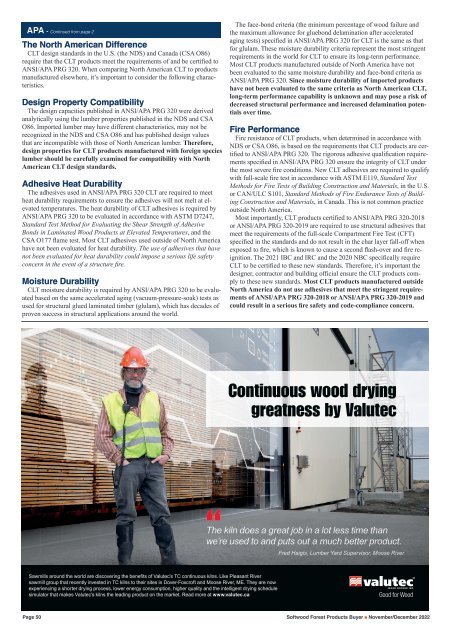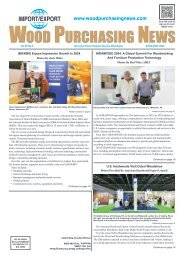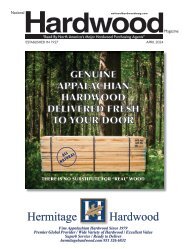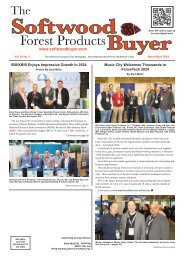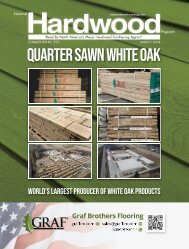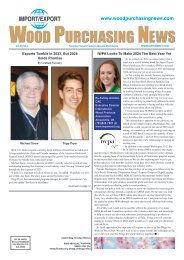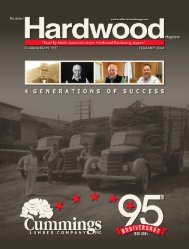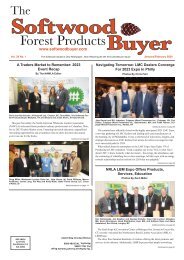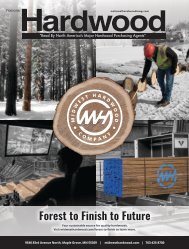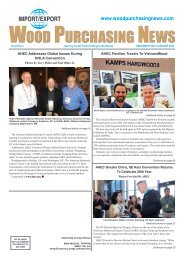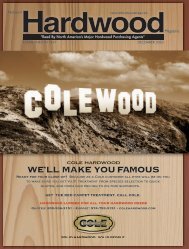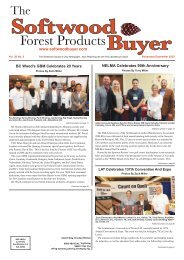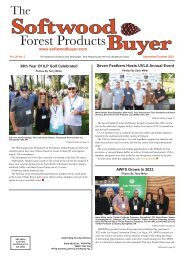The Softwood Forest Products Buyer - November/December 2022
In the latest issue of the Softwood Forest Products Buyer, see photos from the latest NELMA, Global Buyers Mission and LAT conferences, plus stories about Sawmill Surplus LLC and Western Red Cedar.
In the latest issue of the Softwood Forest Products Buyer, see photos from the latest NELMA, Global Buyers Mission and LAT conferences, plus stories about Sawmill Surplus LLC and Western Red Cedar.
Create successful ePaper yourself
Turn your PDF publications into a flip-book with our unique Google optimized e-Paper software.
APA - Continued from page 2<br />
<strong>The</strong> North American Difference<br />
CLT design standards in the U.S. (the NDS) and Canada (CSA O86)<br />
require that the CLT products meet the requirements of and be certified to<br />
ANSI/APA PRG 320. When comparing North American CLT to products<br />
manufactured elsewhere, it’s important to consider the following characteristics.<br />
Design Property Compatibility<br />
<strong>The</strong> design capacities published in ANSI/APA PRG 320 were derived<br />
analytically using the lumber properties published in the NDS and CSA<br />
O86. Imported lumber may have different characteristics, may not be<br />
recognized in the NDS and CSA O86 and has published design values<br />
that are incompatible with those of North American lumber. <strong>The</strong>refore,<br />
design properties for CLT products manufactured with foreign species<br />
lumber should be carefully examined for compatibility with North<br />
American CLT design standards.<br />
Adhesive Heat Durability<br />
<strong>The</strong> adhesives used in ANSI/APA PRG 320 CLT are required to meet<br />
heat durability requirements to ensure the adhesives will not melt at elevated<br />
temperatures. <strong>The</strong> heat durability of CLT adhesives is required by<br />
ANSI/APA PRG 320 to be evaluated in accordance with ASTM D7247,<br />
Standard Test Method for Evaluating the Shear Strength of Adhesive<br />
Bonds in Laminated Wood <strong>Products</strong> at Elevated Temperatures, and the<br />
CSA O177 flame test. Most CLT adhesives used outside of North America<br />
have not been evaluated for heat durability. <strong>The</strong> use of adhesives that have<br />
not been evaluated for heat durability could impose a serious life safety<br />
concern in the event of a structure fire.<br />
Moisture Durability<br />
CLT moisture durability is required by ANSI/APA PRG 320 to be evaluated<br />
based on the same accelerated aging (vacuum-pressure-soak) tests as<br />
used for structural glued laminated timber (glulam), which has decades of<br />
proven success in structural applications around the world.<br />
<strong>The</strong> face-bond criteria (the minimum percentage of wood failure and<br />
the maximum allowance for gluebond delamination after accelerated<br />
aging tests) specified in ANSI/APA PRG 320 for CLT is the same as that<br />
for glulam. <strong>The</strong>se moisture durability criteria represent the most stringent<br />
requirements in the world for CLT to ensure its long-term performance.<br />
Most CLT products manufactured outside of North America have not<br />
been evaluated to the same moisture durability and face-bond criteria as<br />
ANSI/APA PRG 320. Since moisture durability of imported products<br />
have not been evaluated to the same criteria as North American CLT,<br />
long-term performance capability is unknown and may pose a risk of<br />
decreased structural performance and increased delamination potentials<br />
over time.<br />
Fire Performance<br />
Fire resistance of CLT products, when determined in accordance with<br />
NDS or CSA O86, is based on the requirements that CLT products are certified<br />
to ANSI/APA PRG 320. <strong>The</strong> rigorous adhesive qualification requirements<br />
specified in ANSI/APA PRG 320 ensure the integrity of CLT under<br />
the most severe fire conditions. New CLT adhesives are required to qualify<br />
with full-scale fire test in accordance with ASTM E119, Standard Test<br />
Methods for Fire Tests of Building Construction and Materials, in the U.S.<br />
or CAN/ULC S101, Standard Methods of Fire Endurance Tests of Building<br />
Construction and Materials, in Canada. This is not common practice<br />
outside North America.<br />
Most importantly, CLT products certified to ANSI/APA PRG 320-2018<br />
or ANSI/APA PRG 320-2019 are required to use structural adhesives that<br />
meet the requirements of the full-scale Compartment Fire Test (CFT)<br />
specified in the standards and do not result in the char layer fall-off when<br />
exposed to fire, which is known to cause a second flash-over and fire reignition.<br />
<strong>The</strong> 2021 IBC and IRC and the 2020 NBC specifically require<br />
CLT to be certified to these new standards. <strong>The</strong>refore, it’s important the<br />
designer, contractor and building official ensure the CLT products comply<br />
to these new standards. Most CLT products manufactured outside<br />
North America do not use adhesives that meet the stringent requirements<br />
of ANSI/APA PRG 320-2018 or ANSI/APA PRG 320-2019 and<br />
could result in a serious fire safety and code-compliance concern.<br />
Always Look for the APA Trademark<br />
<strong>The</strong> APA trademark is your assurance the CLT was manufactured by<br />
North American producers whose products have been successfully qualified<br />
and certified to ANSI/APA PRG 320. <strong>The</strong> ANSI/APA PRG 320<br />
standard is recognized in the International Building Code (IBC) and International<br />
Residential Code (IRC) in the U.S. and is required for using the<br />
design provisions specified in the National Design Specification for Wood<br />
Construction (NDS). In Canada, ANSI/APA PRG 320 is recognized by the<br />
National Building Code (NBC) when the product is applied in designs that<br />
meet the requirements of CSA O86, Engineering Design in Wood.<br />
Find additional information in Cross-Laminated Timber—North American<br />
CLT vs. Imported Product, Form S500 (www.apawood.org/publication-search?q=s500)<br />
in the APA Resource Library.<br />
About APA – <strong>The</strong> Engineered Wood Association<br />
Founded in 1933 and based in Tacoma, WA, APA represents about 175<br />
plywood, oriented strand board, glulam and cross-laminated timber, wood<br />
I-joist, Rim Board® and structural composite lumber mills throughout<br />
North America. Its primary functions are quality auditing and testing,<br />
applied research, and market support and development.<br />
Learn more at www.apawood.org.<br />
AWC Continued from page 2<br />
few radars in the design, fire, code and wood products industry, it’s important<br />
for a variety of reasons.<br />
<strong>The</strong> new FDS serves to consolidate different design provisions that were<br />
scattered across a spectrum of design manuals, design aids and design<br />
standards. <strong>The</strong> work over the last seven years to produce the FDS brought<br />
all of those provisions under one roof, making it easier and more efficient<br />
for designers, architects, fire service officials and code officials to find<br />
exactly what they need to ensure wood-frame and mass timber buildings<br />
meet the highest standards for fire safety.<br />
In addition to bringing together existing provisions for the structural design<br />
of unprotected wood members exposed to a standardized ASTM E119<br />
fire exposure currently contained in the National Design Specification®<br />
for Wood Construction, the FDS also provides calculation procedures to<br />
address the added fire resistance and thermal benefits of protection provided<br />
by use of additional wood cover, gypsum panel products, and insulation.<br />
Calculation provisions have been developed to provide standardized<br />
methods of calculating thermal separation and burn-through as required in<br />
ASTM E119 and as provided in AWC’s Technical Report 10: Calculating<br />
the Fire Resistance of Exposed and Protected Wood Members (TR10).<br />
From the building code perspective, AWC maintains four other ANSIapproved<br />
standards that are referenced in the building codes, and the<br />
expectation is that the FDS will follow suit. Getting ANSI approval as an<br />
American National Standard is a step beyond the minimum requirements<br />
of consensus standards being recognized in the building code development<br />
process, but does provide evidence to regulators that all steps in the<br />
consensus process were followed.<br />
Development of a standard under a consensus process provides transparency<br />
and ensures the opportunity for meaningful participation by all<br />
groups that are affected. A true consensus process also has procedures to<br />
ensure balance, consideration of dissenting views and a process for appeals.<br />
ANSI is the coordinator of the U.S. standards process and provides<br />
strict objective requirements for accreditation of organizations, such as<br />
AWC, following those processes. <strong>The</strong> ANSI process for establishing new<br />
Continued on page 52<br />
Continuous wood drying<br />
greatness by Valutec<br />
S P E C I A L I Z I N G I N D O U G L A S F I R .<br />
P R I M E F O R E S T P R O D U C T S<br />
I S A S E C O N D A R Y<br />
R E M A N U F A C T U R E R T H A T<br />
P R I D E S I T S E L F O N P R O V I D I N G<br />
H I G H Q U A L I T Y S O F T W O O D<br />
P R O D U C T S W I T H P R I M E<br />
C U S T O M E R S E R V I C E .<br />
<strong>The</strong> kiln does a great job in a lot less time than<br />
we’re used to and puts out a much better product.<br />
Fred Haigis, Lumber Yard Supervisor, Moose River<br />
P R I M E F O R E S T . C O M<br />
Sawmills around the world are discovering the benefits of Valutec’s TC continuous kilns. Like Pleasant River<br />
sawmill group that recently invested in TC kilns to their sites in Dover-Foxcroft and Moose River, ME. <strong>The</strong>y are now<br />
experiencing a shorter drying process, lower energy consumption, higher quality and the intelligent drying schedule<br />
simulator that makes Valutec’s kilns the leading product on the market. Read more at www.valutec.ca<br />
1 - 5 0 3 - 6 2 8 - 0 4 4 1<br />
Page 50 <strong>Softwood</strong> <strong>Forest</strong> <strong>Products</strong> <strong>Buyer</strong> • <strong>November</strong>/<strong>December</strong> <strong>2022</strong> <strong>Softwood</strong> <strong>Forest</strong> <strong>Products</strong> <strong>Buyer</strong> • <strong>November</strong>/<strong>December</strong> <strong>2022</strong> Page 51


